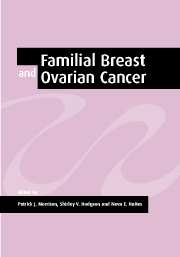Book contents
- Frontmatter
- Contents
- List of contributors
- Foreword by Helena Kennedy
- Preface
- Acknowledgements
- Part 1 Molecular biology and natural history
- Part 2 Screening
- 9 Developing a cancer genetics service: a Welsh model
- 10 Referral criteria for cancer genetics clinics
- 11 Guidelines for the development of cancer genetics services
- 12 Cultural and educational aspects influencing the development of cancer genetics services in different European countries
- 13 Screening, detection and survival patterns of breast and other cancers in high-risk families
- 14 Screening for familial ovarian cancer
- Part 3 Management
- Index
14 - Screening for familial ovarian cancer
Published online by Cambridge University Press: 24 August 2009
- Frontmatter
- Contents
- List of contributors
- Foreword by Helena Kennedy
- Preface
- Acknowledgements
- Part 1 Molecular biology and natural history
- Part 2 Screening
- 9 Developing a cancer genetics service: a Welsh model
- 10 Referral criteria for cancer genetics clinics
- 11 Guidelines for the development of cancer genetics services
- 12 Cultural and educational aspects influencing the development of cancer genetics services in different European countries
- 13 Screening, detection and survival patterns of breast and other cancers in high-risk families
- 14 Screening for familial ovarian cancer
- Part 3 Management
- Index
Summary
Despite advances in surgery and chemotherapy, the overall prognosis for ovarian cancer remains poor. It has improved little over the last 30 years. The best way of improving outcome may be to detect the condition at an early stage through screening the population at risk. The high incidence of disease in those with a strong family history of ovarian cancer makes them particularly amenable to this strategy.
Why should we screen?
There are estimated to be approximately 50 000 women in the UK who have a significant family history of ovarian cancer with two or more affected close relatives. These women have an approximately ten-fold increased risk compared with the general population. This translates to an average lifetime risk of developing ovarian cancer of 15%.
The prognosis for ovarian cancer is generally poor, with an overall 5-year survival of about 30%. Seventy per cent of women are diagnosed with stage III or IV disease, with 5-year survivals of 15–20% and less than 5% respectively (Teneriello and Park, 1995). The lack of symptoms of early ovarian cancer results in women frequently presenting with advanced disease. This is due to the location of the ovaries within the peritoneal cavity, which results in minimal local irritation or interference with vital structures until ovarian enlargement is considerable, or metastasis occurs. Initial symptoms may be so vague that multiple consultations with a GP may occur before a gynaecological referral is initiated.
- Type
- Chapter
- Information
- Familial Breast and Ovarian CancerGenetics, Screening and Management, pp. 220 - 234Publisher: Cambridge University PressPrint publication year: 2002
- 3
- Cited by



